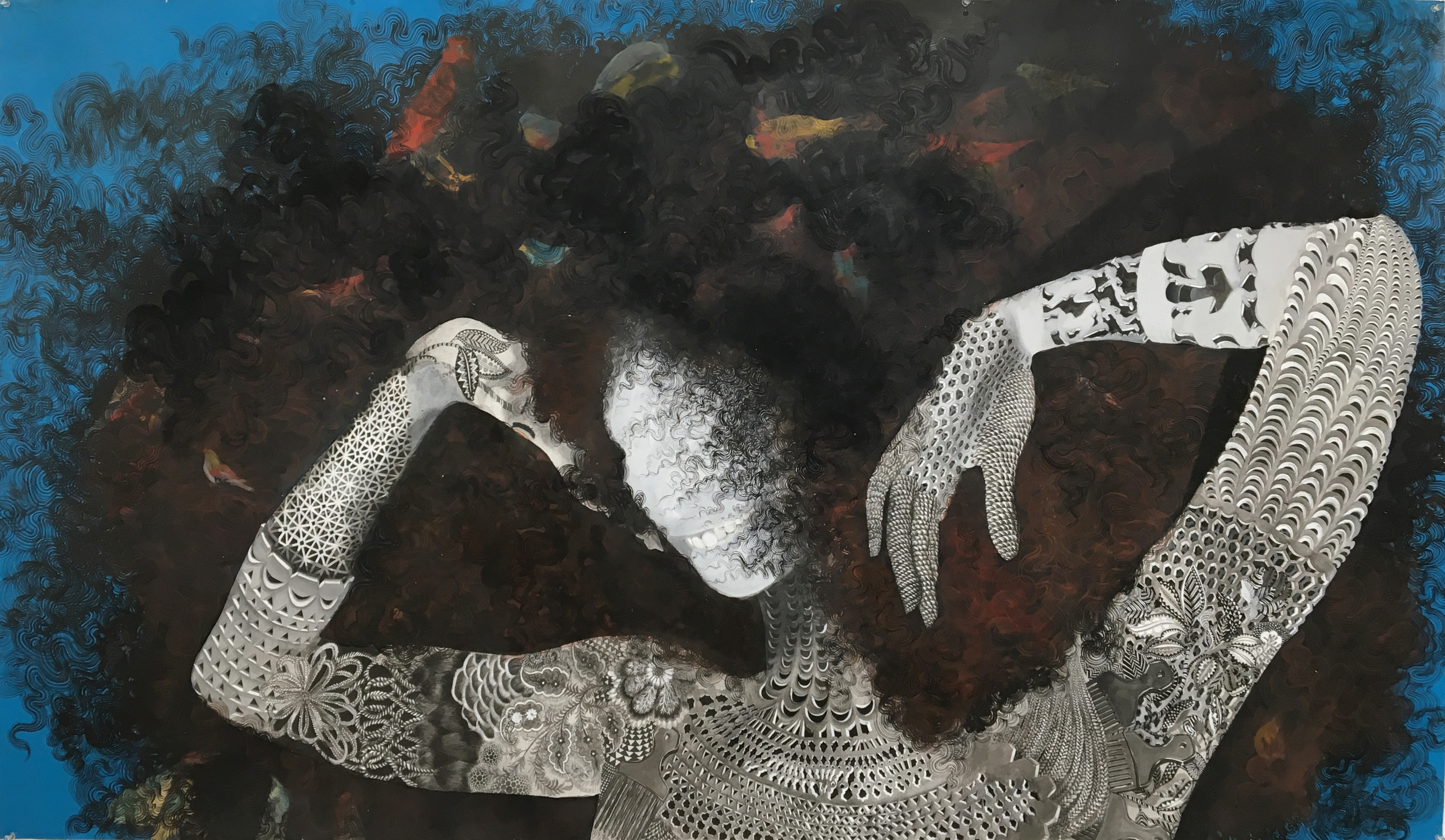 Firelei Báez's painting "Vessel of Genealogies" is on display at the DePaul Art Museum as part of Báez's spring exhibition "Vessels of Genealogies." (Courtesy of the artist and Gallery Wendy Norris)Bright colors, patterns, hairstyles and textiles depicted on large-scale paintings and tapestries will help tell stories of identity, history and politics in the latest DePaul Art Museum exhibition, "Vessels of Genealogies," that's set to open April 27 and run through Aug. 6 on the museum's first floor.
Firelei Báez's painting "Vessel of Genealogies" is on display at the DePaul Art Museum as part of Báez's spring exhibition "Vessels of Genealogies." (Courtesy of the artist and Gallery Wendy Norris)Bright colors, patterns, hairstyles and textiles depicted on large-scale paintings and tapestries will help tell stories of identity, history and politics in the latest DePaul Art Museum exhibition, "Vessels of Genealogies," that's set to open April 27 and run through Aug. 6 on the museum's first floor.
Organized by the Tarble Arts Center at Eastern Illinois University, "Vessels of Genealogies" by Miami-based artist Firelei Báez is curated by Maria Elena Ortiz, the associate curator at the Pérez Art Museum in Miami.
"Visitors will be able to connect to Firelei Báez's experience as an individual who migrated to the U.S. to improve her life conditions and become an American," Ortiz says. "But at the same time they will be exposed to new strategies for identity formation experienced by people of Latin, Caribbean and African descent. I think that this is particularly important because Báez's work challenges the basic idea of how race is experienced in the U.S. - a condition defined as binary and black or white. In her work, one can appreciate that she is many cultures. She expresses the consciousness of a new generation eager to embrace their cultural prowess in terms of hybridity."
The exhibition title "Vessels of Genealogies" comes from an acrylic, graphite and ink-based painting, "Vessel of Genealogies," that features a completely tattooed female with flowing hair and is part of the exhibition coming to DePaul.
Báez was inspired to make this piece after researching West African body masks featuring Vejigantes, a folkloric Caribbean character that wears highly ornate colors in carnival celebrations, according to Ortiz. The figure is covered in patterns related to these two motifs, as her body becomes masks that connect her to her ancestors. "Here, there is certainly an impetus to express the human capacity to merge different cultures to create something new," Ortiz says.
Another important piece in the exhibit is the painting, "Can I Pass? Introducing the Paper Bag to the Fan Test for the Month of July, 2011." Made of gouache, ink and graphite on panel, the painting features 30 different outlines of Báez and her different hairstyles for the month.
"I think that Báez is trying to portray the absurdities of racial categorization, how race has been 'determined' by ridiculous assertions of phenotype in the U.S. and the Dominican Republic," Ortiz says. "What I find most interesting, is how this work brings forth the complexities of the U.S.-Latin identity in relation to the African-American experience. In the U.S., Latin communities experience significant discrimination, and even within their own communities there are racial hierarchies in which Afro-Latinos and indigenous cultures are often disregarded as less than their European counterparts. In this sense, Báez brings the U.S.-Latin and African-American experiences to an even field, especially when considering racism and discrimination."
The exhibition also features some of Báez's earliest work, including "Daughters of the Revolution" and "Ode to La Siréne (and to muses beyond Jean Luc Nancy's Canon)." The work "CPT Symmetry (echoing Marie Laveau's manipulations of the elusive mirror image of matter)" established Báez's career and focuses on her investigations of the tignon, a headdress that free women of color were obligated to wear in antebellum New Orleans, according to Ortiz. "These three works have rarely been exhibited in public and established Báez's role as a leading voice in her generation," she adds.
"At the DePaul Art Museum, we are committed to providing a platform for under-recognized artists," says Julie Rodrigues Widholm, the museum's director and chief curator. "It's very important that we present the work of female artists with diverse perspectives, and as a museum, we would like to be a leader in presenting the work of great female artists who have a perspective that isn't regularly seen in museums."
Admission is free at the DePaul Art Museum. Museum hours are Wednesdays and Thursdays from 11 a.m. to 7 p.m., Fridays from 11 a.m. to 5 p.m., and Saturdays and Sundays from noon to 5 p.m. The museum is closed Mondays and Tuesdays. For more on DePaul Art Museum's upcoming exhibitions and events, call 773-325-7506 or visit http://museums.depaul.edu/.